The rights side of history: Long Islanders who worked for women's suffrage
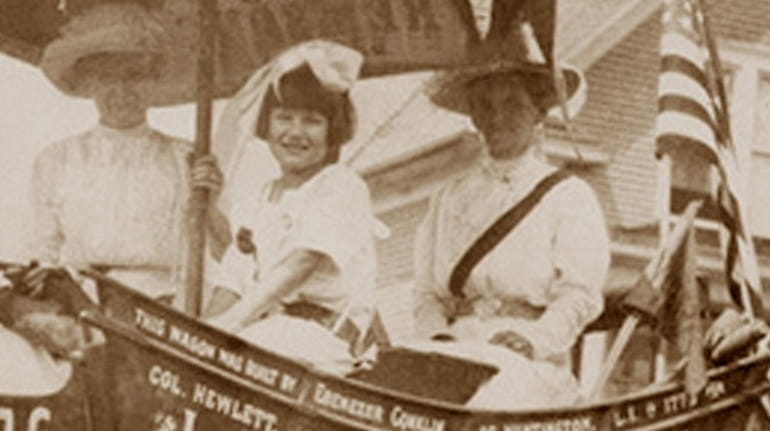
Sitting in the Suffragist wagon, from left, are Edna Buchman Kearns, her daughter Serena Kearns and Irene Davison, a suffragette activist, on Long Island, circa 1913. Credit: Courtesy Marguerite Kearns
Anyone looking at the touring car packed with gaily dressed women and children holding aloft suffragist signs in early 1900s photos might consider them touching scenes from a serene past. Maybe the passengers on board, such as Edna Buckman Kearns, would hand out a few pamphlets, then head to a lawn party where the children could chase each other around the garden.
Actually, historians say it was a clever photo op during a time that was anything but peaceful.
The picture was to remind people that if nothing were done, the little girls on board would grow up as second-class citizens, without the right to vote. Kearns and other activists, women often spat upon, jeered and pelted with eggs during their tours, set out on a campaign to change this. They accosted firemen in firehouses, chatted up barbers and cajoled construction workers in ditches. They marched in high-top shoes for the equivalent of several marathons, dropped leaflets from biplanes and did the unthinkable — confronted a stiff-backed president about his lack of concern.
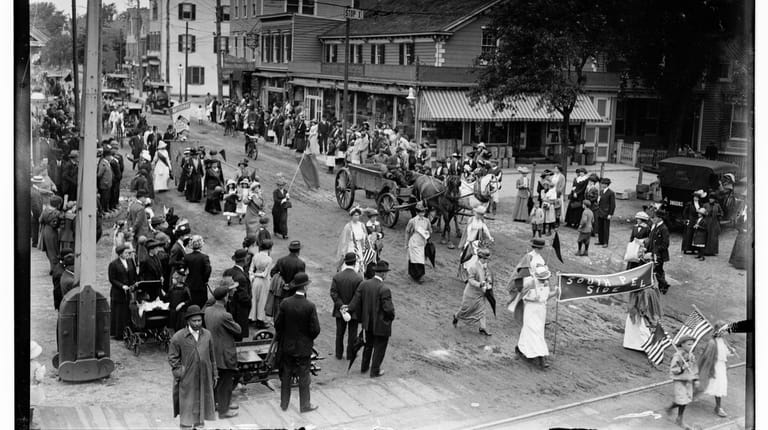
Activists march in a suffrage pageant and parade in Mineola on May 24, 1913. The parade went from Mineola to Hempstead. Credit: Library of Congress
Society’s reaction was severe.
During one infamous incident after a protest in Washington, D.C., a Brooklyn woman, Lucy Burns, was jailed and tortured; handcuffed with her hands above her head in a jail cell. When she and fellow female prisoners went on a hunger strike, platters of fried chicken were brought in to tempt them. No one touched the food. Eventually, four guards tried to pry open Burns’ mouth to force-feed her, then gave up and shoved a feeding tube down her nose until it bled.
“It wasn’t easy,” Antonia Petrash, a historian and author of “Long Island and the Woman Suffrage Movement” (Arcadia Publishing, 2013), says of the struggle in a resentful, male-dominated society filled, strangely, with a contingency of women also outraged by the action. “It never is.”
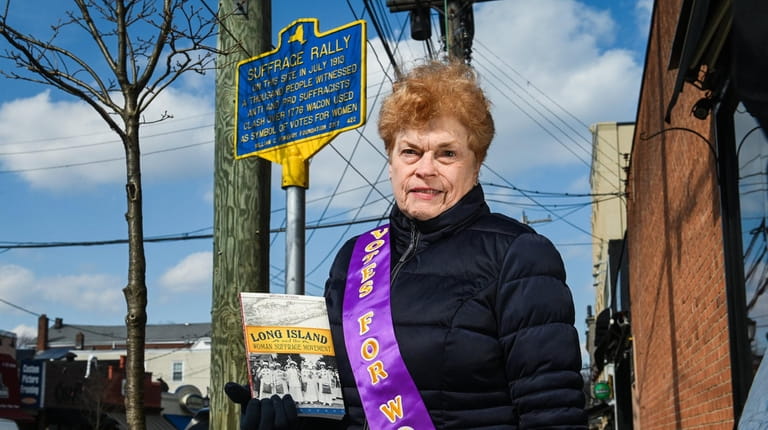
Antonia Petrash, of Glen Cove, holds her book, "Long Island and the Woman Suffrage Movement," near the plaque in Huntington that marks where a confrontation occurred in 1913 between supporters and opponents of women's right to vote. Credit: Newsday/Steve Pfost
This year marks the 100-year anniversary of the ratification of the 19th Amendment, when women won the right to vote nationally. The event seems inevitable looking back. In fact, it was an edgy historical drama that stretched decades — one in which women on Long Island not only played an important role but helped accelerate.
“Many parts of Long Island are remote from present activities and intensely conservative,” Kearns wrote during a road trip to generate support. “But they show signs of awakening.”
The start of the movement usually is associated with the 1848 women’s rights convention in upstate Seneca Falls. It was sidelined by the Civil War, and advocates were disappointed in 1870 when the 15th Amendment gave the vote to black men but denied it to women of any color. But by the turn of the 20th century, several states had passed legislation in their favor. When suffragists became more aggressive, with tactics such as burning President Woodrow Wilson in effigy, outraged onlookers punched and choked them while police stood by with folded arms. Later, the women were jailed and brutalized at a filthy abandoned prison.
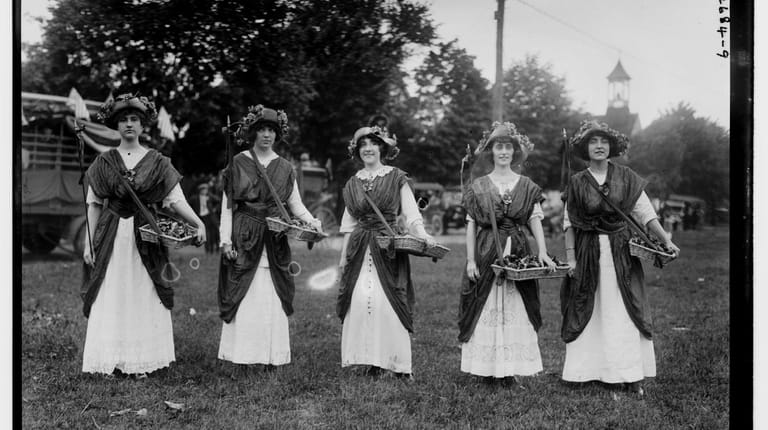
Women in suffrage pageant and parade sell flowers on Long Island in 1913. Credit: Library of Congress
By 1919 political pressure forced the U.S. House and Senate to pass the 19th Amendment. It was ratified nationally the next year by the required number of states when a reluctant 24-year Tennessee legislator voted yes to break a tie, obeying his mother’s plea to “be a good boy.”
The women of Long Island were not shrinking violets when it came to this fight.
“They were gutsy,” says Natalie Naylor, a former Hofstra University professor, director of its Long Island Studies Institute and author of “Women in Long Island’s Past” (The History Press, 2012). They also were savvy in coming up with ways to convert a disapproving public, she says. “They got a lot of publicity.”
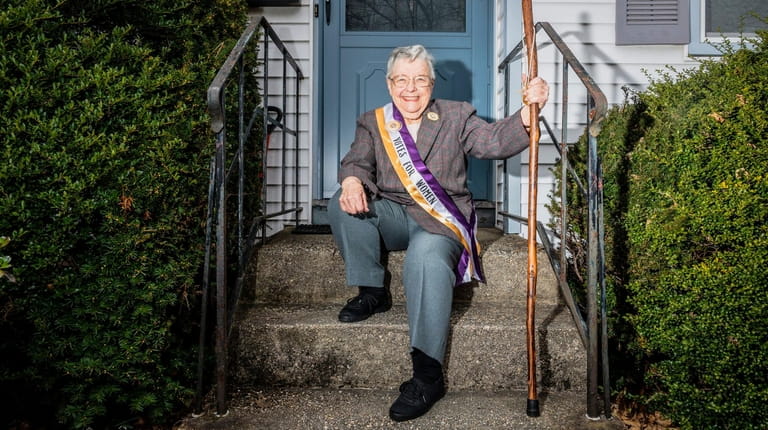
Natalie Naylor, a former Hofstra University professor, director of its Long Island Studies Institute and author of "Women in Long Island's Past" (The History Press, 2012), outside her home in Uniondale on March 3, 2020. "They were gutsy," Natalie Naylor says of the suffragists. Credit: Newsday/Alejandra Villa Loarca
Several were wealthy supporters (some called them the “Mink Brigade”) with summer homes on the Island who were recruited because of their time and money. For example, Louisine Havemeyer, who had a home in Islip, possessed one of the finest art collections in the world and displayed it to raise funds for the cause. After a timid start, she became a zealot who went on a hunger strike after being jailed at age 62 for demonstrating in front of the White House.
Alva Vanderbilt Belmont, a relentless woman who married for money and got it, contributed huge sums to the movement although she often alienated people with her bluntness. But she bailed imprisoned women out of jail, held a massive rally in New York City’s Hippodrome and helped to organize picketers. Belmont also encouraged integrating the movement by inviting African American women and immigrants to retreats at her French Renaissance castle in Sands Point.
“She could have just been a dilettante, but she stuck herself out there,” Petrash says.
One of the most effective militants to step forward was Rosalie Gardiner Jones, known as “The General.” Born into a prominent Long Island family from Cold Spring Harbor (her ancestor was Lion Gardiner, founder of the first British settlement in New York), she was a strong-willed woman who grasped the value of headlines. Her personal crusade began in 1911 by giving a speech to three women and a dog in Roslyn. Later, she organized a march from the Bronx to Albany and another from Newark to Washington, D.C., with military precision. The participants walked with blistered feet through frigid weather. Only about a half dozen made it to the end, but others joined along stretches and helped spread the word. At a parade to the White House the day before Wilson’s inauguration, they were attacked by onlookers and had banners ripped from their hands.
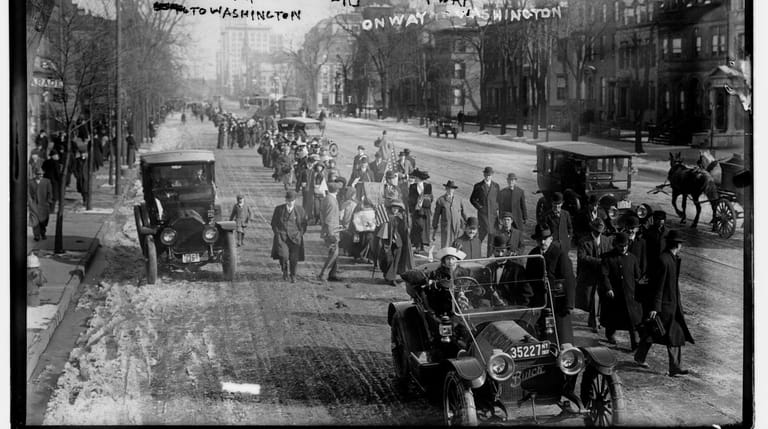
Women's suffrage supporters, led by "General" Rosalie Jones (walking behind the first car), hiked from New York to Washington, D.C., for the March 3, 1913, National American Woman Suffrage Association parade. This photo was taken Feb. 12, 1913, on Broad Street in Newark. Credit: Library of Congress
“It turned out to be a riot,” Naylor says.
Harriet Burton Laidlaw, a Sands Point woman, was among those who helped persuade Theodore Roosevelt to support the cause and had hoped he would participate in a 1912 suffragist parade down Fifth Avenue. A few weeks before the date, he was shot while making a speech (he recovered, but his “Bull Moose” Party lost the presidency). Laidlaw, the parade chairman, was disappointed, but picked up a torch and joined 20,000 marchers down the avenue, a sight that drew an estimated half-million onlookers. Naylor notes that Harriet’s husband, James, who was chairman of the Men’s League for Woman Suffrage, marched along with her. He is the only man listed on a suffrage plaque by the League of Women Voters displayed in the New York State Capitol.
“Men in the movement were heckled mercilessly,” Naylor says. “It was considered an affront to masculinity.”
Still, it was women of ordinary means — often restrained by household duties and child-rearing — who supplied the movement’s foot soldiers.
One of the most active was Edna Buckman Kearns, who lived in Rockville Centre with her supportive husband, Wilmer, and daughter Serena, who became known as the “youngest suffragist.”
“She [Edna] didn’t let anything get in her way,” says Marguerite Kearns, an author in New Mexico who is writing a book about her grandmother. “She was determined and firm and talented in communications.”
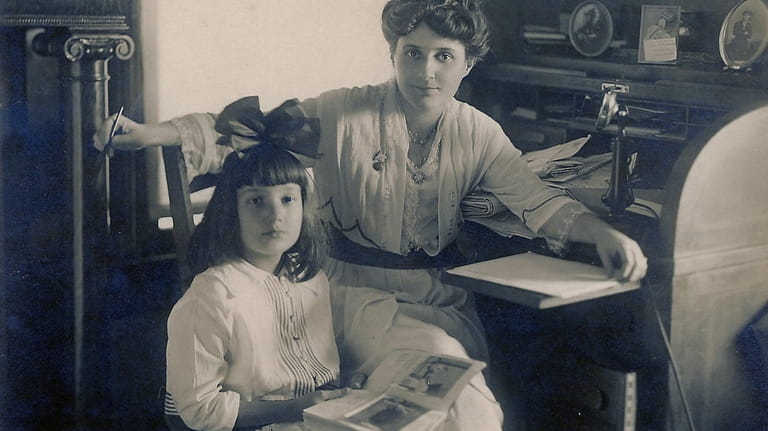
Suffrage leader Edna Buckman Kearns with her daughter Serena Kearns, circa 1915 in Rockville Centre. Credit: Courtesy Marguerite Kearns
Born into an activist Quaker family that helped slaves escape on the Underground Railroad and advocated for gender equality, Edna's family wasn’t rich, so she worked for a living. But her job as a suffragist columnist for a variety of papers, including the Brooklyn Daily Eagle, created a record of the time. In an article in 1915, she wrote about envying neighbors who had enough leisure time to chat on their porches. She bit her lip and toiled away.
“Do you scowl at the ice-man or the milkman or answer your fellow suffragist crossly over the phone when they disturb your rest around eight in the morning after you’ve been up till the wee morning hours of the night before? You do not,” she wrote. “Do you snap at a reporter or fellow worker who calls you on the phone at twelve or one at night to ask for news? You do not. Do you tell editors and reporters exactly what you think of them? Do you carry out your inclination to shake them at times? You do not! You smile kindly, speak sweetly and chide them gently.”
She and other suffragists climbed aboard a flag-draped borrowed touring car in 1912 and blitzed Long Island literally from one end to the other, giving impromptu speeches. Like other speakers, she often was taunted for not staying home to take care of her family. This probably is why at one meeting, she made a point of mentioning she had put up 17 cans of peas and six cans of raspberries that morning.
When she heard opponents were making a film in Rockville Centre that was going to feature a house burning supposedly by suffragists, she rushed to the scene. Shouting to the hundred or so actors and producers on the set, she warned there would be a severe backlash against their propaganda. They made the movie but left the house intact.
Not only was she among those who picketed the White House, so was her daughter Serena, who made the papers holding a sign that said, “Mr. President, What Will You Do For Woman’s Suffrage?” Kearns’ reputation spread when she began touring in her suffragist horse-drawn wagon labeled the “Spirit of 1776,” donated to the cause by a Brooklyn carriage company. It actually had been built in the mid-1800s, but Kearns rode around dressed in Colonial-era clothing anyway, playing on the Revolutionary War’s “taxation without representation” theme. An episode that took place during a parade in Huntington serves as a good example of the animosity she encountered.
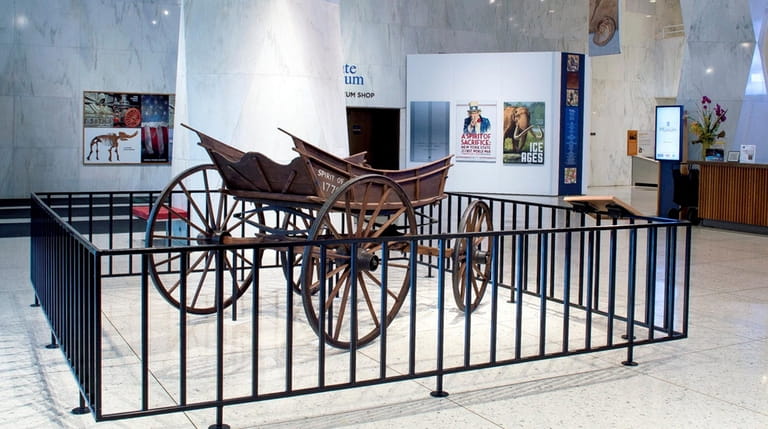
"Spirit of 1776" wagon is on display in April 2018 at the New York State Museum during the Votes for Women exhibition. The wagon was used in New York City and Long Island suffrage parades and pageants. Credit: New York State Museum
The event was a popular annual gathering where dignitaries gave speeches. In the midst of the festivities, Mary Livingston Jones planted herself in front of Kearns’ oncoming wagon and declared it did not belong to the cause and couldn’t be used for its promotion.
“Everything stopped,” Marguerite Kearns says. “That’s when the confrontation took place.”
The reason for the stir was that Jones was the matriarch of a prominent, land-owning family on Long Island referred to in one article as possibly the richest woman in the United States. Even more striking was the fact that she was an ardent anti-suffragist and, ironically, the mother of the movement’s celebrated activist “General” Rosalie Gardiner Jones.
“You can imagine the breakfast table talk in that household,” Petrash says.
Apparently, the elder Jones threatened to sue if the suffragists kept on using the vehicle.
What happened after that is clouded in history, but the wagon was not surrendered and Kearns continued her buckboard crusade. A plaque describing the event was erected two years ago at the corner of Main and Wall streets in Huntington. (The wagon is in the permanent collection of the New York State Museum in Albany and will be on display from March 10 to Sept 10. It is slated to come to the Long Island Museum in Stony Brook for public viewing from Oct. 17 to Dec. 27.)
Grassroots activities such as this built momentum for the cause, but Petrash believes the nearly two years of protesting in front of the White House and the mistreatment of imprisoned women was decisive. After she was freed, Lucy Burns organized “Prison Special” train trips across the country to talk about the incidents. She and the other women on board, all suffragists who had been jailed at some point, wore brooches shaped as prison doors and dressed in prison garb when they gave their speeches.
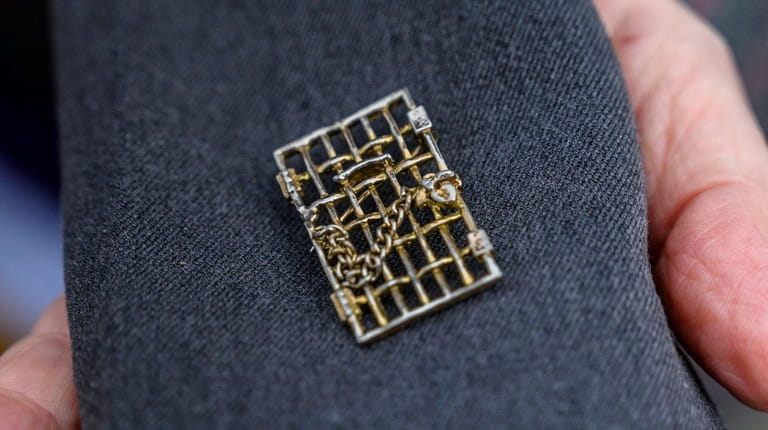
Natalie Naylor displays a replica of the jail-door brooch worn by women who were jailed in the fight for women's suffrage. Credit: Newsday/Alejandra Villa Loarca
New York women won the right to vote in November 1917. In 1919 the U.S. Senate finally passed the amendment, and the next year 36 states ratified it to make it the law of the land.
Ida Sammis, a suffragist and a member of a well-known Huntington family, became one of the first two women elected to the New York State Legislature, taking office in January 1919.
Just because the amendment was now law didn’t make it popular with men. On her first day at work, Sammis was stopped by a guard who barred the door with a rifle and told her it was restricted to members of the Assembly. He cursed but let her pass after she presented her credentials.
When Sammis took her seat, she found a spittoon at her feet and did something that signified women were in government to stay. According to legend, she polished it, placed it atop her desk and filled it with flowers.
Celebrate, then vote
The League of Women Voters branches located throughout Suffolk and Nassau counties are planning a series of teas and PowerPoint presentations at area libraries in August to mark the passage of the 19th Amendment, says Arlene Hinkemeyer, chairman of the 100th-anniversary celebration committee for the League in the Hamptons, Shelter Island and the North Fork.
“People these days don’t understand what was involved,” she says, noting that the amendment’s passage took hundreds of campaigns over 72 years using a national strategy devised by suffragist Carrie Chapman Catt. She was president of the National American Woman Suffrage Association and founder of the National League of Women Voters on Feb. 14, 1920, when NAWSA voted to change its name.
Only one woman from the 1848 Seneca Falls Convention, Charlotte Woodward Pierce, was still alive by then, Hinkemeyer says. She was too ill to go to the polls in 1920 at age 91 and died the next year without ever exercising her right to vote.
“The League will be making a concerted effort to get out the vote and to educate and inform the public so they feel ready for the coming election,” says Nancy Rosenthal, president of the Nassau County League of Women Voters.
